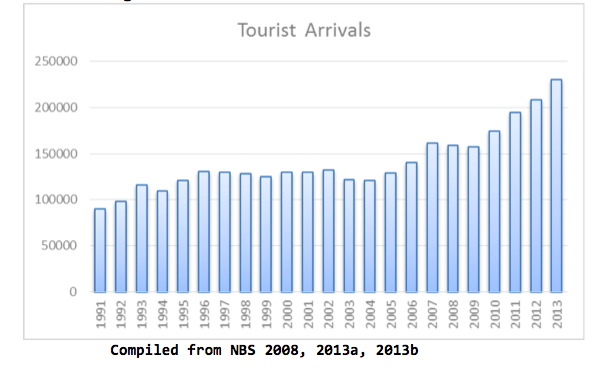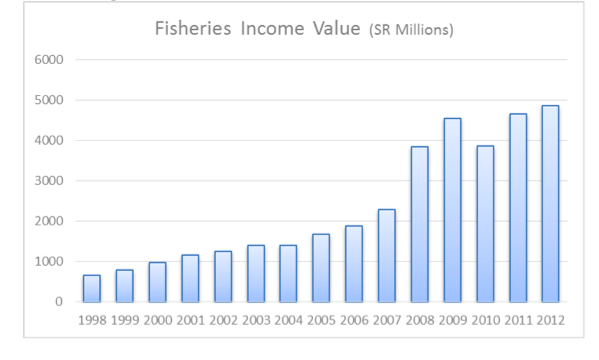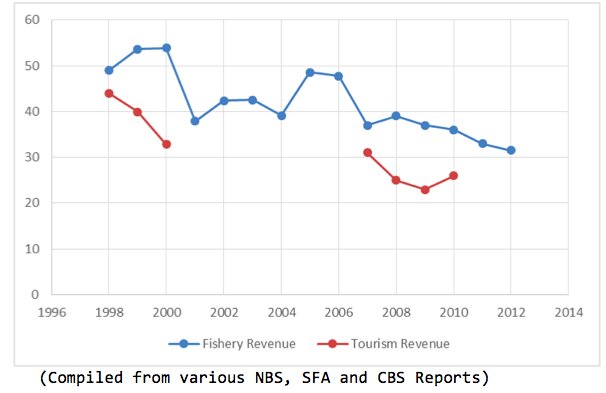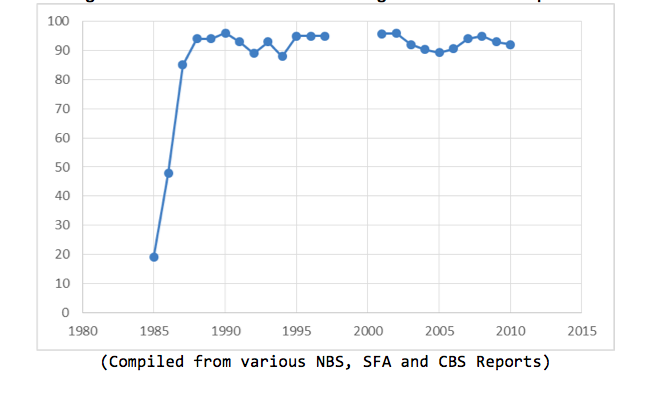Status & Trends
The Republic of Seychelles lies in the western Indian Ocean and is made up of granitic and coralline 115 islands. The rocks of most of the granitic islands are some 750 million years old and originate from Gondwana, the ancient Southern super continent. When this super-continent broke up, the various sections slowly drifted apart to form Africa, Australia, Madagascar and India, leaving Seychelles isolated in the Indian Ocean.The country’s Exclusive Economic Zone (EEZ) spreads across 1.4 million square km of combined ocean and land mass. The Seychelles is recognised as a biodiversity hotspot and a centre of plant biodiversity by Conservation Seychelles and International Union for the Conservation of Nature (IUCN) and the World Wildlife Fund (WWF).
Throughout its history, Seychelles’ biodiversity has been of critical importance both as a daily necessity and the starting-point beginnings for economic activity. Today the Seychelles depends on its tourism and fishing industries to support the country’s social services and drive its socioeconomic development. Attempts have been made to further diversify the economy with offshore banking and international business zones but tourism and fisheries remain far and away the two main components of the national economy (GOS 2014).
Fisheries, both artisanal and industrial, are directly dependent upon the sound management of marine resources, whilst tourism in Seychelles is based upon the aesthetic beauty of the islands with their tropical flora and fauna, white sand beaches and clear blue waters. All of these characteristics are derived from a healthy, clean and productive environment. Nature-based tourism and ecotourism activities represent the fastest growing component of the international tourism trade and Seychelles has maximised the marketing of its healthy and beautiful environment and endemic species of flora and fauna. The private sector in particular has shown strong recognition of the importance of biodiversity as a key factor in attracting the high revenue clientele it seeks. This has been embodied in the ecological rehabilitation of several islands in the central archipelago with the removal of invasive alien species (IAS) and the (re)introduction of threatened endemic species as part of national conservation programmes in tandem with the marketing of said islands as exclusive hotel ecotourism resorts (GOS 2014).
1.1. Tourism industry
Tourism is the largest sector of the Seychelles economy accounting for 26% of GDP and employing over one third of the country’s workforce in 2008. A record total of 230,272 tourists visited the country in 2013.
Figure 1. Tourist Arrivals, 1991-2013
Tourism has proved to be a resilient economic sector which continued to grow despite global impacts from both Gulf Wars and the global economic crisis that commenced in 2008. Despite the ongoing fragility of international money markets and poor economic growth in Seychelles’ main tourism markets, visitor numbers soon returned to growth and indeed at an escalated rate. This was likely fostered by the significant devaluation of the Seychelles currency at that time but also coincided with the implementation of a reinvigorated national marketing campaign. Revenue however has not grown at the same rate as visitor numbers reflecting in part the new exchange rate equilibrium.
Environmental and biodiversity attractions form the primary basis for international marketing with Seychelles being in particular renowned for:
- the endemic Coco-de-mer palm (Lodoicea maldivica) which amongst various notable characteristics sports the largest seed of any plant in the world,
- the Giant tortoise (Aldabrachelys gigantea). In recent times however other attractions have also come to the fore such as the central archipelago’s rare endemic birds, the unique palm forest of Praslin and the rich and diverse attraction of the near shore marine environment with turtles, marine life and including seasonal aggregations of the largest fish in the world, the whale shark (Rhincodon typus), developing their own tourism markets.
1.2. Fisheries
Fishing is a vital economic sector for Seychelles and central to national food security. In 2012 approximately 5,500 people were employed directly or indirectly in the fisheries sector constituting 12% of total formal employment. Approximately 70% of the workforce are employed in the industrial tuna fishery and ancillary services, the artisanal fishery constitutes between 1,300-1,400 fishers depending on seasonal variations in activity, the sea cucumber fishing industry employed 150 people in 2011 with another 120 employed in fishery management, administration and research under the auspices of the Seychelles Fishing Authority.
Fisheries revenue has risen steadily over the last 20 years (see Fig 2.); the revenue upsurge in 2008 being due to the devaluation of the Seychelles rupee.
Figure 2. Fisheries Income 1998-2012
Fisheries have consistently been the main national earner of foreign exchange (Figure 3). Official figures from the Central Bank Annual Report indicate that in 2012, tourism earnings amounted to SR 4.247 billion or 27% of current account receipts whilst the earning from fisheries and related activities accounted for 31% of current account receipts.
Figure 3 Fisheries and Tourism Revenues as Percentage of Foreign Exchange Income
Fisheries are the dominant visible export accounting for an average of 92.6% of visible exports from 1987 to 2010 (see Figure 4)
Figure 4: Fisheries as a Percentage of National Exports
The sector faces multiple challenges however as there is extensive evidence that the demersal stocks of the Mahé plateau are over fished (Section 2.1, GOS 2014) and consequently issues of overcapacity in the domestic fleet need to be addressed. The industrial fishery faces similar problems with the Indian Ocean Tuna Commission clearly lacking the capacity to effectively address issues of by-catch and illegal, unreported and unregulated fishing (IUU*). Data regarding key by-catch species of the fishery, in particular, is chronically deficient and a key barrier to the informed and adaptive management of by-catch issues
Seychelles’ Fourth National Report to the CBD, submitted in March 2011, included a lengthy assessment of the status and trends of the country’s biodiversity. In the three years since that report, as one might expect, there have been no major changes in said status and trends. Trends that were in general negative at that time remain so today and likewise with the habitat types and species that were considered stable or exhibiting positive trends.
There has however been significant progress made in the understanding of the status of elements of Seychelles’ biodiversity both terrestrially and marine through targeted, management oriented research, particularly in the domain of fisheries and terrestrially in terms of the assessment of Key Biodiversity Areas. There have also been some excellent direct management interventions that have yielded rapid benefits in terms of the status of certain threatened biodiversity. Below are the two main elements mentioned above in brief. However for the broader issues and some of the specific notable findings and interventions which are elaborated upon in case studies can be found in Section 7 (GOS 2014).
Terrestrial Biodiversity (GOS 2014)
For much of the first 180 years of Seychelles human history, limited fishing technology and capacity meant that terrestrial ecosystems bore the brunt of development and production pressure. Giant tortoises were extirpated on many islands to provide meat to ships. The hardwood forests were felled for timber for construction, shipbuilding and as an export commodity. Low-lying forest was subsequently clear felled to make way for coconut plantations, whilst higher altitude forests in the main granitic islands were felled to provide fuel for the cinnamon oil distilleries (see Fourth National report for details). The decline of the copra and cinnamon markets, coupled with the rise of tourism and industrial fisheries saw the Seychelles economy shift from its agrarian base, changing the pressures of land use. The agricultural (1.9% GDP – GFM 2014) and forestry (<0.4% GDP – Vielle 2001) sectors are now of very limited significance and in chronic decline in terms of contribution to GDP. As a consequence, the area of land under (secondary) forest cover has increased markedly over the last 40 years. Land use pressure now fits the typical Small Island Developing State “coastal squeeze” scenario where the vast majority of infrastructure, human habitation and commercial activities vie for space on the thin coastal strip of land. This has resulted in ever growing pressure on coastal habitats and manifested itself in various phases of coastal reclamation around the three main populated islands Mahe, Praslin and La Digue. Notable habitat types under pressure include lowland forest and beach crest habitats in the granitic islands but most significantly lowland inland waters, which are the most threatened of native habitat types due to historical and ongoing reclamation, drainage, siltation and pollution.
Marine Biodiversity (GOS 2014)
The marine and coastal biodiversity of Seychelles has been fundamental to socioeconomic development since human colonisation in the late 18th century. Man’s early resource exploitation saw the demise of certain key mega fauna from the marine and coastal ecosystem, notably the salt water crocodile and two species of seal, and the dramatic decline of others such as sharks and marine turtle populations. Since the 1950s, these declines have continued and spread down the food chain to meso-consumers. Both the “fishing down” of the food chain and the lowering of the catch trophic index are notorious portents of declining resources, reduced revenue and degradation of broader ecosystem function and service provision. Urgent action is needed in the form of a significant restructuring of fishery governance and management approaches to address these negative trends. A key precursor to informed action is improved gathering, management and analysis of data on species, habitats and ecosystems. In this regard, significant progress has been made in the Seychelles in the last three years.
GoS (2014). Fifth National Report to the United Nations Convention on Biological Diversity. Ministry of Environment and Energy, P.O. Box 445, Botanical Gardens, Mont Fleuri, Victoria, Republic of Seychelles. Report prepared by John Nevill.
GFM (2014). Global Finance Magazine: Seychelles Country Report (Agriculture GDP contribution for 2011). http://www.gfmag.com/gdp-data-country-reports/183-the-seychelles-gdp-country-report.html#axzz2xABNLwRh (27/03/14)
Vielle, M. (2001). Seychelles. Forestry Outlook Studies in Africa (FOSA) Rome, July 2001




